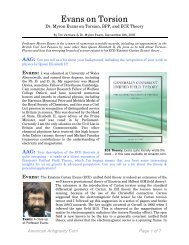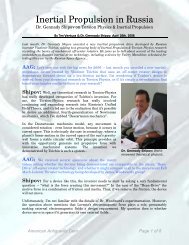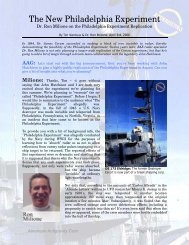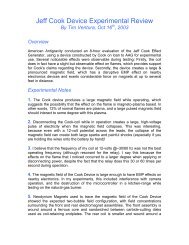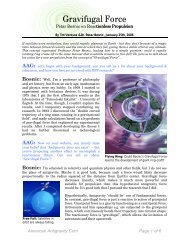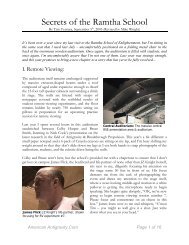Sharon-Weinberger-In.. - American Antigravity
Sharon-Weinberger-In.. - American Antigravity
Sharon-Weinberger-In.. - American Antigravity
You also want an ePaper? Increase the reach of your titles
YUMPU automatically turns print PDFs into web optimized ePapers that Google loves.
usiness sector that wouldn’t exist were it not for the SBIR process. On the other hand, as you<br />
point out, you have the stealth belt buckle issue.<br />
But you have to understand why that exists. If you’re not solving a problem the military needs,<br />
what good are you doing, and who will buy your fabulous technology? On the other hand, I<br />
suppose if you want true innovation, you don’t want to overly limit proposals. Maybe the<br />
solution is to strike a balance between the two: practical problems and far-reaching ideas.<br />
AAG: What about over-engineering: the best example is NASA designing the space-pen with<br />
a pressure-loaded cartridge to write upside down without running dry, while the Russians<br />
effectively solved the same issue by issuing their cosmonauts pencils. Does the incentive to drive<br />
large, financially-profitable defense-contracts lead us towards these Rube Goldberg style<br />
approaches to solve everyday challenges, and has this been addressed at all in the defenseindustry?<br />
<strong>Weinberger</strong>: That’s a good question, but I would reply with, “it depends.” When you’re<br />
dealing with multibillion dollar weapon systems, you sometimes can’t afford for little things to<br />
go wrong. On the other hand, you don’t want to create a billion dollar solution to something a<br />
stick of gum can fix.<br />
“We should never dismiss any idea out of hand as being fringe...<br />
We should challenge orthodoxy and encourage free thinking.”<br />
AAG: I'd like to focus on aerospace for just a second, because I've talked to Nick Cook over at<br />
Janes a few times about industry trends, and he's very concerned that aerospace is going<br />
through a period of profound decline right now. For instance, the average age of most aerospace<br />
engineers is 55 years old, because the industry only produces refinements on mature<br />
technologies, which means that young innovators go for the high-paychecks & creative<br />
fulfillment of the IT industry rather than aerospace. Can you give us your thoughts on this<br />
industry, and whether it's really in decline or not?<br />
<strong>Weinberger</strong>: Cook is very correct. My brother for example, studied aerospace<br />
engineering at Stanford about 10 years ago, and like most of his colleagues, went into computer<br />
programming. That’s where the excitement was—aerospace wasn’t a fun or creative field to be<br />
in. There’s going to be a big crisis as the current generation of aerospace engineers retires; I<br />
don’t think anyone knows what to do about it. There needs to be a lot more funding for basic<br />
research and development—that will help attract younger workers. But I don’t know if that’s<br />
politically feasible right now. Where will the money come from?<br />
How to fix it? I’m just not sure. Maybe we need simply to accept that IT, and not aerospace, is<br />
the growth field. My guess is that for the aerospace industry to be reinvigorated, we’ll need the<br />
next breakthrough in propulsion—that technology that really will effectively get us to Mars and<br />
beyond. So, there needs to a big push into R&D, but I don’t see that money coming down the<br />
pike.<br />
AAG: Well as a professional who works across a variety of defense-related industries, which<br />
ones would you say are really on the upswing right now? Can you give us an idea of what the<br />
players & technologies are that are going to really be making an impact in 21st century defense?<br />
<strong>American</strong> <strong>Antigravity</strong>.Com Page 10 of 11



